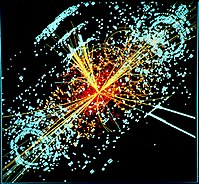
Back آلية هيغز Arabic Механізм Хігса Byelorussian Механизъм на Хигс Bulgarian হিগস ক্ষেত্র Bengali/Bangla Mecanisme de Brout-Englert-Higgs Catalan Higgs-Mechanismus German Μηχανισμός Χιγκς Greek Higgs mechanism English Mecanismo de Higgs Spanish سازوکار هیگز Persian

The Higgs field is a field of energy that is thought to exist in every region of the universe. The field is accompanied by a fundamental particle known as the Higgs boson, which is used by the field to continuously interact with other particles, such as the electron. Particles that interact with the field are "given" mass and, in a similar fashion to an object passing through treacle (or molasses), will become slower as they pass through it. The result of a particle "gaining" mass from the field is the prevention of its ability to travel at the speed of light.
Mass itself is not generated by the Higgs field; the act of creating matter or energy from nothing would violate the laws of conservation. Mass is, however, gained by particles via their Higgs field interactions with the Higgs boson. Higgs bosons contain the relative mass in the form of energy and once the field has endowed a formerly massless particle, the particle in question will slow down as it has now become "heavy".
If the Higgs field did not exist, particles would not have the mass required to attract one another, and would float around freely at light speed.
Giving mass to an object is referred to as the Higgs effect. This effect adds mass to any particle that interacts with the field.